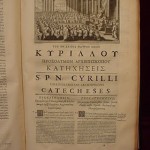 Cyril of Jerusalem, the fourth-century theologian, bishop, and Doctor of the Church, wrote a prolific number of lectures addressed to adult catechumens preparing for full entrance into the Church, compiled into what we refer to as the Mystagogical Catecheses. Overflowing with rich theological exegesis and detailed descriptions of the catechumenate process, Cyril’s ancient lectures provide an exceptional insight into the practice of adult initiation into the Church—one that had fallen out of use for centuries until the Second Vatican Council’s restoration of the practice in the “Constitution on the Sacred Liturgy,” Sacrosanctum Concilium. Since then, the 1988 Rite of Christian Initiation of Adults has become the primary vehicle for adult initiation in the Catholic Church. Yet, its efficacy is one of arguably varied success.
Cyril of Jerusalem, the fourth-century theologian, bishop, and Doctor of the Church, wrote a prolific number of lectures addressed to adult catechumens preparing for full entrance into the Church, compiled into what we refer to as the Mystagogical Catecheses. Overflowing with rich theological exegesis and detailed descriptions of the catechumenate process, Cyril’s ancient lectures provide an exceptional insight into the practice of adult initiation into the Church—one that had fallen out of use for centuries until the Second Vatican Council’s restoration of the practice in the “Constitution on the Sacred Liturgy,” Sacrosanctum Concilium. Since then, the 1988 Rite of Christian Initiation of Adults has become the primary vehicle for adult initiation in the Catholic Church. Yet, its efficacy is one of arguably varied success.
David Yamane’s paper “Initiation Rites in the Contemporary Catholic Church: What Difference Do They Make?”[1] for the Review of Religious Research sheds some much-needed light on the current state of Catholic initiation practices in the United States. Yamane addresses the type of question both liturgists and catechists constantly wrestle with regarding the effectiveness of their work. Specifically, “Do individuals who participate in the RCIA process in the Catholic Church experience an increase in ecclesial involvement and spiritual practice?” Utilizing advanced sociological research methods and  supplementing them with the work of eminent theologians, Yamane endeavors to identify the extent of change in different domains of religiosity over the course of the RCIA process, based on data collected in two waves between 2000 and 2002 and encompassing 159 individuals throughout 32 different parishes in the diocese of Fort Wayne-South Bend. His conclusion: the RCIA process can make a significant, positive difference in the ecclesial involvement and spiritual practice of initiates, but only in parishes that have more fully implemented initiation programs. As a liturgist who has studied the rites of Christian initiation with one of the theologians referenced in this study, I agree wholeheartedly with Yamane’s conclusion.[2]
supplementing them with the work of eminent theologians, Yamane endeavors to identify the extent of change in different domains of religiosity over the course of the RCIA process, based on data collected in two waves between 2000 and 2002 and encompassing 159 individuals throughout 32 different parishes in the diocese of Fort Wayne-South Bend. His conclusion: the RCIA process can make a significant, positive difference in the ecclesial involvement and spiritual practice of initiates, but only in parishes that have more fully implemented initiation programs. As a liturgist who has studied the rites of Christian initiation with one of the theologians referenced in this study, I agree wholeheartedly with Yamane’s conclusion.[2]
It is clear in Yamane’s paper that the success of the RCIA program has significant implications for the state of the Catholic Church at large, especially when considering the dependent variables (ecclesial involvement and spiritual practice) and independent variables (level of implementation, parish size, RCIA rating, and voluntary RCIA hours) Yamane employs in this particular study. Aidan Kavanagh, one of the giants in my field of liturgical studies, argued that the process of initiating new members “defines simultaneously both the Christian and the Church, and the definition is unsubordinated to any other except the gospel itself.”[3] Thus it is imperative for the liturgical integrity of U.S. Catholicism that parishes across the country encourage robust initiation programs. Yamane finds (and substantiates) that lackluster catechesis, truncated periods of mystagogy, diminished levels of enthusiasm within RCIA programs, and the “school year” model are factors that negatively impact the religiosity of catechumens in the RCIA process. On the other hand, the most successful RCIA programs are often the most liturgically informed. These tend to take an ongoing approach to the precatechumenate, hold multiple Rites of Acceptance throughout the liturgical year, require at least a year of formation, practice the Rite of Dismissal on a regular basis, and engage in a much longer period of mystagogy after one’s full reception in the Church (50 days).
Ultimately, it is quite evident in Yamane’s study that a continuous initiation process fosters a more vibrant liturgical life in parishes regarding ecclesial involvement and spiritual practice. The focus in these parishes is not so much on a finite period of conversion and initiation, after which the community settles down and gradually forgets about the process until the next catechumenate cycle. Rather, it is one that encourages the congregation at large to remember and re-live on a regular basis their own initiation in the Church. The collective memory of the congregation is therefore constantly strengthened by this revivification of mystagogia and liturgical awareness.
Yamane’s study poses several excellent questions and provides some solid initial answers regarding the current state of initiation practices in the Catholic Church, but it raises still more questions about their future. The questions Yamane’s study poses are crucial for pastoral development. Obviously, his key question is this: does the RCIA process as it stands now in the Catholic Church have a significant effect on its initiates’ ecclesial involvement and their individual spiritual practice? But his research raises additional questions for liturgists, catechists, and other parish ministers: does their work through RCIA potentially have a positive effect on parishioners’ (not just initiates) ecclesial involvement and spiritual practice? The issue of full implementation in Yamane’s study matters heavily here, too, since it has been my experience that well-trained liturgists and parish ministers with more fully implemented programs tend to have more active ecclesial involvement in their parishes, not just among converts who went through the RCIA program but among ordinary cradle Catholic parishioners as well.
Additional questions about the future of initiation in the Church stem from my own curiosity about the long-term effectiveness of these RCIA programs. Yamane’s study covered a year’s worth of data collected in two waves: Fall 2000-Summer 2001, and Fall 2001-Summer 2002. Obviously the period of time was constrained for the purposes of the study, but has there been any research done on the level of religious change of individuals who completed the RCIA process after an extended period of time has passed (i.e. several years)? Indeed, Dr. Yamane has probably already considered this. Another question I’d like to ask Dr. Yamane is how the religiosity of RCIA Catholics compares to that of the rest of their parish community. A significant differentiation, whether positive or negative, would certainly necessitate the revision of overall parish administration practices, and produce fruitful discussion for theologians and sociologists alike. In any event, I look forward to Yamane’s forthcoming book, Becoming Catholic: Finding Rome in the American Religious Landscape, for further discoveries that will undoubtedly yield a more detailed analysis of initiation in American Catholicism.
I agree with Yamane for the most part. I did find, however, (and Yamane cites me but I can’t remember exactly on what at this moment) that some parishes in the City of Detroit who have a strong sense of community (which included non-Catholics) found the RCIA process (program) to be an obstacle to initiation. For example, when a non-Catholic from the neighborhood finally decided to become Catholic they found all of the stages and periods of the RCIA to be too much. This person already knew everybody and knew the bible better than most Catholics. They just wanted to know about the saints, the tabernacle, and a few other Catholic things. Indeed, even lectionary based catechesis was an obstacle. However, in most of the suburban parishes, where a communal sensibility was low, I would say Yamane’s data suggesting a more intense initiation process works better is accurate.